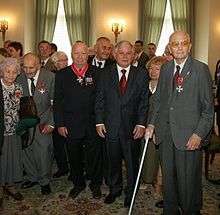Stanisław Aronson
| Stanisław Aronson | |
|---|---|
 Stanisław "Rysiek" Aronson (left) (decorated with the Order of Polonia Restituta 3rd Class) and President of Poland Lech Kaczyński | |
| Nickname(s) | Rysiek |
| Born |
1925 Warsaw, Poland |
| Rank | Podpułkownik (Poland) / Sgan Aluf (Israel) |
| Battles/wars |
Warsaw Uprising Israeli War of Independence Yom Kippur War 1982 Lebanon War |
| Awards |
|
Stanisław Aronson (nom de guerre "Rysiek") (born 1925 in Warsaw[1]) is a Polish Jew and an Israeli citizen, as well as a former officer of the Polish Home Army (AK) with a rank of Lieutenant. He was also a member of the elite Kedyw unit, "Kolegium A", of the Warsaw Region of AK, a participant in the Warsaw Uprising of 1944, and a Lieutenant Colonel of the Israeli Defense Force who took part in the Israeli War of Independence, the Yom Kippur War and the 1982 Lebanon War.
Aronson's mother family came from Łódź. After the German invasion of Poland in 1939, they first moved from Łódź to Warsaw.[2] After a few days, they decided to move further east to the Kresy, where near Równo their relatives owned some land.[2] However, in the meantime the Soviet Union also invaded Poland as part of the Molotov-Ribbentrop Treaty between the Soviet Union and Nazi Germany, and the relatives were arrested by the NKVD and deported eastwards, deep within the Soviet Union.[2] As a result, the family tried to unsuccessfully enter Lithuania, and then into Romania.[2] Eventually they wound up in Soviet-occupied Lwow.[2] According to Aronson, in Lwow, the Soviets pressured Poles, Ukrainians and Jews to sign up for the Komsomol but he personally refused.[2]
After Operation Barbarossa, the German invasion of the Soviet Union began, German troops entered Lwow. This resulted in a series of pogroms beginning, and the Germans began transporting Jews out of the city. Despite the fact that the Aronson family had documents which listed them as Poles, they were forced to flee again. In the autumn of 1941 they arrived in the Warsaw Ghetto which in their view was a better place than the Nazi concentration camps that other Jews from Lwow were sent to.[2]
During the liquidation of the Warsaw Ghetto the whole family ended up on Umschlagplatz where they got separated.[2] Stanisław never saw his family again. He himself was put on a transport to Auschwitz but managed to escape while the train was parked in the countryside near Warsaw. He spent the night hiding in a nearby chapel and then made his way to a nearby village. A local farmer gave him shelter, food and transportation to the nearby rail station. Aronson went back to Warsaw, where he made contact with Polish friends that lived on the "Aryan" side.[3] They organized a hiding place for him and later, false documents in the name of "Ryszard Żurawski" (later Żukowski). Soon he was contacted by the Polish Home Army and asked to join the anti-Nazi resistance.[2] He was member of selected Kedyw groups (patrole) carried out executions of Nazi collaborators and traitors sentenced by an underground courts.[4] He also took part in the Warsaw Uprising of 1944.
Military decorations
- Commander of the Order of Polonia Restituta with Star (2013)
- Commander of the Order of Polonia Restituta (2007)
- Officer of the Order of Merit of the Republic of Poland (1997)
- Cross of Valour (Poland) – two times
- Armia Krajowa Cross
- Warsaw Cross of the Uprising
- Army Medal for War 1939-45 (Poland) – two times
- Gold Polish Army Medal
- Decoration of Honor – "Medal of Honor for Merit to the Military Gendarmerie" (2014)
- Medal for the 1948 Arab–Israeli War (Israel)
- Medal for the Yom Kippur War (Israel)
- Medal for the 1982 Lebanon War (Israel)
Bibliography
- Stanisław Aronson, Patrycja Bukalska, Rysiek z Kedywu. Niezwykłe losy Stanisława Aronsona, Znak, Kraków 2009 ISBN 978-83-240-1170-4
Internet
- [English] A story of Stanisław (Shlomo) Aronson
- [Polish] Patrycja Bukalska, Ostatnia wojna Stanisława Aronsona, Polish press article "Tygodnik Powszechny" 2004
- [Polish] Piotr Zychowicz, Z ziemi polskiej do izraelskiej, Polish press article - "Rzeczpospolita" 2008
- [Polish] Piotr Zychowicz, Żyd z Armii Krajowej, Polish press article -"Rzeczpospolita" 2009
- [Polish] , Interview with "Rysiek" in Archiv of Warsaw Uprising Museum, http://ahm.1944.pl
- [Polish] Odznaczenia kombatantów z okazji Dnia Weterana, on internet sites of Polish President - www.prezydent.pl
References
- ↑ Book review of "Rysiek z Kedywu. Niezwykłe losy Stanisława Aronsona" (Rysiek from Kedyw. The incredible life of Stanisław Aronson), by Patrycja Bukalska, Znak publishers,
- 1 2 3 4 5 6 7 8 9 Patrycja Bukalska, "Ostatnia wojna Stanisława Aronsona" (The Last War of Stanisław Aronson", Tygodnik Powszechny, 2004-11-07,
- ↑ Stanisław Aronson, Patrycja Bukalska, Rysiek z Kedywu. Niezwykłe losy Stanisława Aronsona, Kraków 2009 ISBN 978-83-240-1170-4
- ↑ , Interview with "Rysiek" in Archiv of Warsaw Uprising Museum, http://ahm.1944.pl